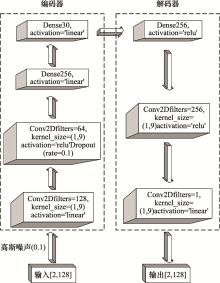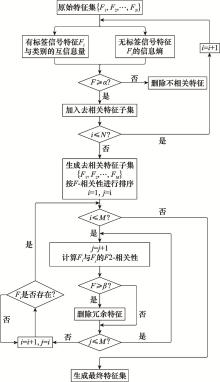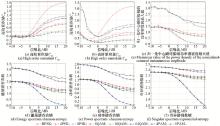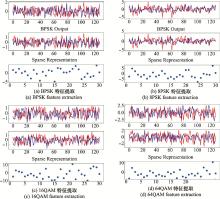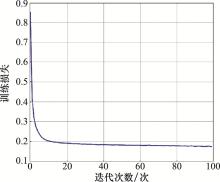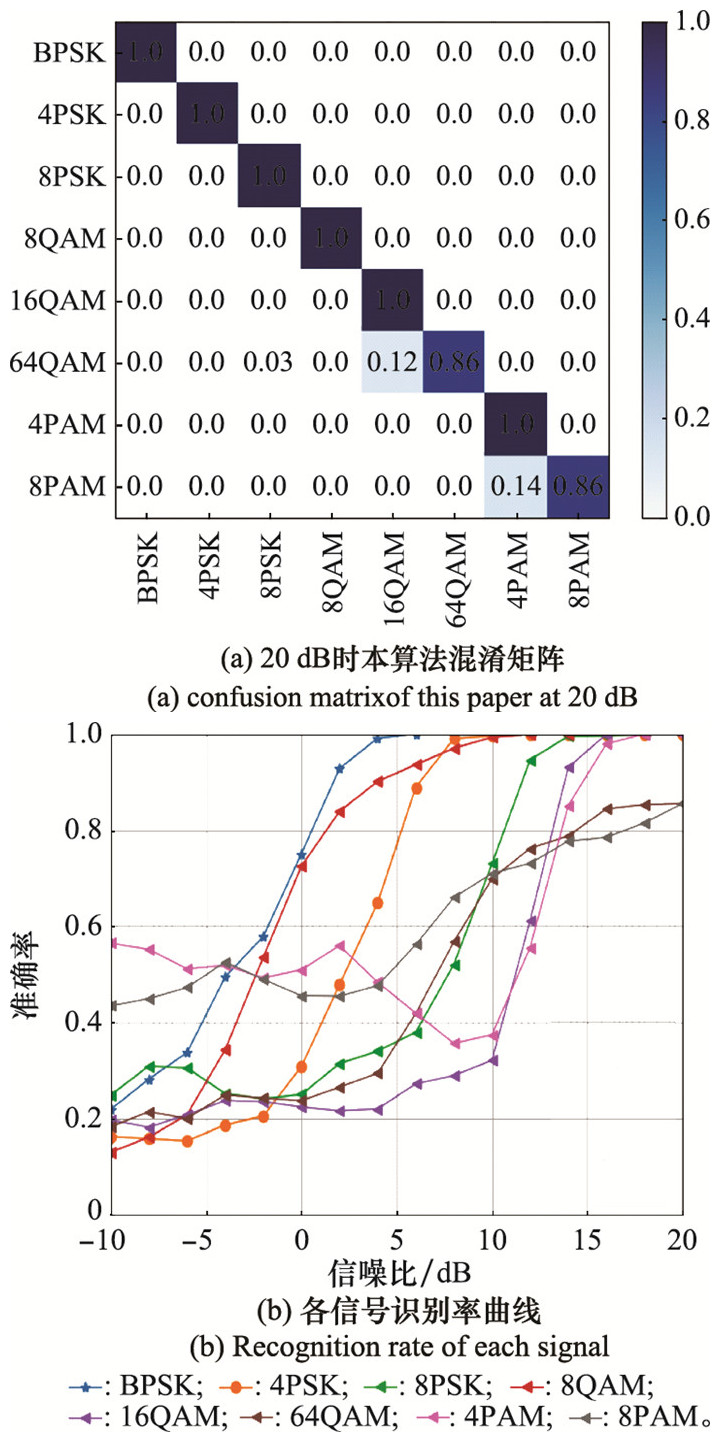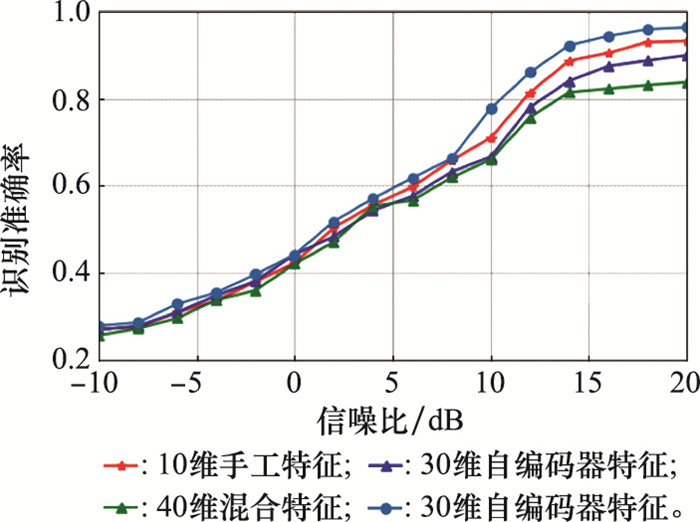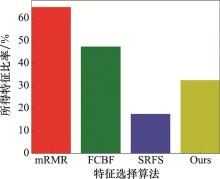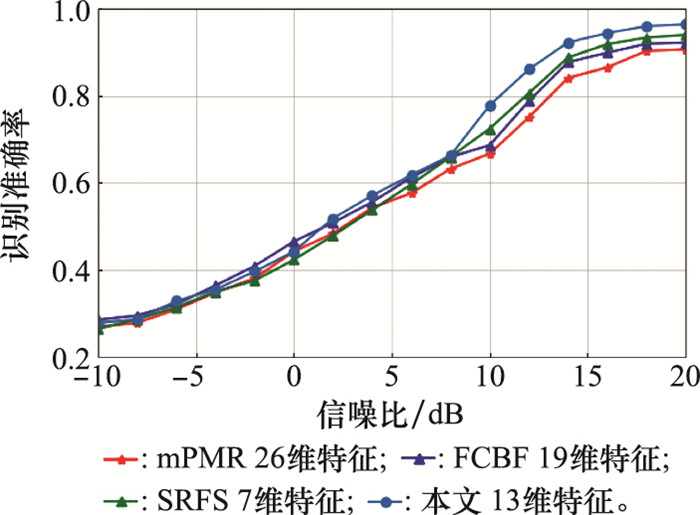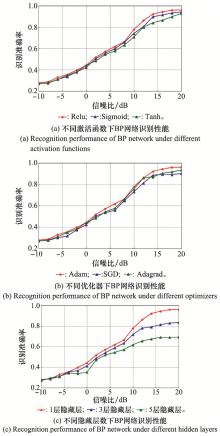Systems Engineering and Electronics ›› 2021, Vol. 43 ›› Issue (4): 1099-1109.doi: 10.12305/j.issn.1001-506X.2021.04.28
• Communications and Networks • Previous Articles Next Articles
Few-shot modulation recognition method based on ensemble learning and feature dimension reduction
Yunhao SHI*( ), Hua XU(
), Hua XU( ), Wanze ZHENG(
), Wanze ZHENG( ), Yinghui LIU(
), Yinghui LIU( )
)
- Information and Navigation College, Air Force Engineering University, Xi'an 710077, China
-
Received:2020-06-08Online:2021-03-25Published:2021-03-31 -
Contact:Yunhao SHI E-mail:shiyunhaoai@163.com;13720720010@139.com;107011650@qq.com;YingHui_Liu@163.com
CLC Number:
Cite this article
Yunhao SHI, Hua XU, Wanze ZHENG, Yinghui LIU. Few-shot modulation recognition method based on ensemble learning and feature dimension reduction[J]. Systems Engineering and Electronics, 2021, 43(4): 1099-1109.
share this article
Table 1
Feature subset of each selection algorithms"
| 特征选择算法 | 所选特征数 | 特征子集 | 时间/s |
| mRMR | 26 | f2、f3、f5、f6、f7、f8、f9、f10、f11、f12、f14、f15、f16、f19、f21、f22、f27、f28、f30、f31、f32、f33、f34、f35、f36、f37 | 0.7 |
| FCBF | 19 | f3、f6、f7、f8、f9、f10、f12、f14、f15、f16、f19、f21、f27、f28、f30、f32、f34、f36、f37 | 1.3 |
| SRFS | 7 | f3、f9、f12、f16、f26、f27、f36 | 37.4 |
| 本文算法 | 13 | f3、f7、f8、f9、f10、f12、f16、f19、f21、f27、f32、f36、f37 | 9.8 |
| 1 |
KHARBECH S , DAYOUB I , SIMON E , et al. On classifiers for blind feature-based automatic modulation classification over MIMO Channels[J]. IET Communications, 2016, 10 (7): 790- 795.
doi: 10.1049/iet-com.2015.1124 |
| 2 |
ZHE X , YONG G . Method to reduce the signal-to-noise ratio required for modulation recognition based on logarithmic properties[J]. IET Communications, 2018, 12 (11): 1360- 1366.
doi: 10.1049/iet-com.2018.0030 |
| 3 | GHASEMI S, GANGAL A. An effective algorithm for automatic modulation recognition[C]//Proc. of the IEEE 22nd Conference on Signal Processing and Communications Applications, 2014: 903-906. |
| 4 |
SHERME A E . A novel method for auto-matic modulation recognition[J]. Applied Soft Computing, 2012, 12 (1): 453- 461.
doi: 10.1016/j.asoc.2011.08.025 |
| 5 | WANG H, GUO L L. A new method of automatic modulation recognition based on dimension reduction[C]//Proc. of the IEEE Forum on Cooperative Positioning and Service, 2017: 316-320. |
| 6 |
ZHANG Z , LI Y B , JIN S S , et al. Modulation signal recognition based on information entropy and ensemble learning[J]. Entropy, 2018, 20 (3): 198- 198.
doi: 10.3390/e20030198 |
| 7 |
WANG H , GUO L L , DOU Z , et al. A new method of cognitive signal recognition based on hybrid information entropy and D-S evidence theory[J]. Mobile Networks and Applications, 2018, 23 (4): 677- 685.
doi: 10.1007/s11036-018-1000-8 |
| 8 | O'SHEA T J, CORGAN J, CLANCY T C, et al. Convolutional radio modulation recognition networks[C]//Proc. of the International Conference on Engineering Applications of Neural Networks, 2016: 213-226. |
| 9 |
O'SHEA T J , ROY T , CLANCY T C , et al. Over-the-air deep learning based radio signal classification[J]. IEEE Journal of Selected Topics in Signal Processing, 2018, 12 (1): 168- 179.
doi: 10.1109/JSTSP.2018.2797022 |
| 10 | JEONG S, LEE U, KIM S C. Spectrogram-based automatic modu-lation recognition using convolution neural network[C]//Proc. of the IEEE 10th International Conference on Ubiquitous and Future Networks, 2018: 843-845. |
| 11 |
FAN M , PENG C , LENAN W , et al. Automatic modulation classification: a deep learning enabled approach[J]. IEEE Trans.on Vehicular Technology, 2018, 67 (11): 10760- 10772.
doi: 10.1109/TVT.2018.2868698 |
| 12 | ZHANG Z , WANG C , GAN C , et al. Automatic modulation classification using convolutional neural network with features fusion of SPVWD and BJD[J]. IEEE Trans.on Signal and Information Processing over Networks, 2019, 16 (4): 1- 15. |
| 13 |
李跃, 郭兴吉, 赵欣. 基于高阶累积量的调制方式识别研究[J]. 西南科技大学学报, 2018, 33 (3): 64- 68.
doi: 10.3969/j.issn.1671-8755.2018.03.013 |
|
LI Y , GUO X J , ZHAO X . Study on modulation recognition based on higher-order cumulants[J]. Journal of Southwest University of Science and Technology, 2018, 33 (3): 64- 68.
doi: 10.3969/j.issn.1671-8755.2018.03.013 |
|
| 14 | 谭晓衡, 褚国星, 张雪静, 等. 基于高阶累积量和小波变换的调制识别算法[J]. 系统工程与电子技术, 2018, 40 (1): 171- 177. |
| TAN X H , ZHU G X , ZHANG X J , et al. Modulation recognition algorithm based on highorder-cumulants and wavelet transform[J]. Systems Engineering and Electronics, 2018, 40 (1): 171- 177. | |
| 15 | 李晨, 杨俊安, 刘辉. 基于信息熵和GA-ELM的调制识别算法[J]. 系统工程与电子技术, 2020, 42 (1): 223- 229. |
| LI C , YANG J A , LIU H . Modulation recognition algorithm based on information entropy and GA-ELM[J]. Systems Engineering and Electronics, 2020, 42 (1): 223- 229. | |
| 16 |
ALI A , FAN Y Y . Automatic modulation classification using deep learning based on sparse autoencoders with non-negativity constraints[J]. IEEE Signal Processing Letter, 2017, 24 (11): 1626- 1630.
doi: 10.1109/LSP.2017.2752459 |
| 17 | YA T, LIN Y, WANG H. Modulation recognition of digital signal based on deep auto-ancoder network[C]//Proc. of the IEEE International Conference on Software Quality, Reliability and Security Companion, 2017: 256-260. |
| 18 | O'SHEA T J, CORGAN J, CLANCY T C. Unsupervised representation learning of structured radio communication signals[C]//Proc. of the Learning for Intelligent Machines, 2016. |
| 19 | ASLAM M W , ZHU Z , NANDI A K . Automatic modulation classification using combination of genetic programming and KNN[J]. IEEE Trans.on Wireless Communication, 2012, 11 (8): 2742- 2750. |
| 20 | ANG J C, HARON H, NUZLY H, et al. Semi-supervised SVM-based feature selection for cancer classification using microarray gene expression data[C]//Proc. of the International Conference on Industrial, 2015: 468-477. |
| 21 | HAN Y H , YANG Y , YAN Y , et al. Semi-supervised feature selection via spline regression for video semantic recognition[J]. IEEE Trans.on Neural Networks Learning System, 2015, 26 (6): 252- 264. |
| 22 |
BENABDESLEM K , HINDAWI M . Efficient semi-supervised feature selection: constraint, relevance, and redundancy[J]. IEEE Trans. on Knowledge and Data Engineering, 2014, 26 (5): 1131- 1143.
doi: 10.1109/TKDE.2013.86 |
| 23 | SHEIKHPOUR R , SARRAM M A , GHARAGHANI S , et al. A survey on semi-supervised feature selection methods[J]. Pattern Recognition, 2016, 31 (3): 35- 45. |
| 24 | YU L , LIU H . Efficient feature selection via analysis of relevance and redundancy[J]. Journal of Machine Learning Research, 2004, 5 (12): 1205- 1224. |
| 25 | WANG Y T , WANG J D , LIAO H . An efficient semi-supervised representatives feature selection algorithm based on information theory[J]. Pattern Recognition, 2017, 61 (5): 11- 52. |
| 26 | PENG H , LONG F , DING C . Feature selection based on mutual information: criteria of max-dependency, max-relevance, and min-redundancy[J]. IEEE Trans.on Pattern Analysis and Machine Intelligence, 2005, 27 (4): 1226- 1238. |
| 27 | ZHANG S C , LI X L . Learning K for KNN classification[J]. ACM Trans.on Intelligent System and Technology, 2017, 8 (8): 1- 19. |
| [1] | Juncheng GUO, Gang WAN, Xinjie HU, Fabao YAN, Shuai WANG. Meta-learning method for solar radio spectrum burst recognition [J]. Systems Engineering and Electronics, 2022, 44(8): 2410-2418. |
| [2] | Bo LI, Jiahao ZHOU, Minmin LIU, Pinchao ZHU. Feature selection for welding defect assessment based on improved NSGA3 [J]. Systems Engineering and Electronics, 2022, 44(7): 2211-2218. |
| [3] | Bowei QIN, Lei JIANG, Hua XU, Zisen QI. Modulation recognition algorithm based on residual generation adversarial network [J]. Systems Engineering and Electronics, 2022, 44(6): 2019-2026. |
| [4] | Kai SHAO, Miaomiao ZHU, Guangyu WANG. Modulation recognition method based on generative adversarial andconvolutional neural network [J]. Systems Engineering and Electronics, 2022, 44(3): 1036-1043. |
| [5] | Qinzhe LYU, Yinghui QUAN, Minghui SHA, Shuxian DONG, Mengdao XING. Ensemble deep learning-based intelligent classification of active jamming [J]. Systems Engineering and Electronics, 2022, 44(12): 3595-3602. |
| [6] | Qi LIU, Xinyu ZHANG, Yongxiang LIU. Few-shot SAR target recognition based on gated multi-scale matching network [J]. Systems Engineering and Electronics, 2022, 44(11): 3346-3356. |
| [7] | Jun MA, Jingyu YANG, Liyan ZOU. Generation method of operational system of systems capability graph based on Stacking integrated meta-model [J]. Systems Engineering and Electronics, 2022, 44(1): 154-163. |
| [8] | Langcai CAO, Xiaochang LIN, Sixing SU. Unsupervised feature selection based on matrix factorization and adaptive graph [J]. Systems Engineering and Electronics, 2021, 43(8): 2197-2208. |
| [9] | Zhigang JIN, Tong WU. Intrusion detection based on feature selection and tree Parzen estimation [J]. Systems Engineering and Electronics, 2021, 43(7): 1954-1960. |
| [10] | Ruifeng LI, Aiqiang XU, Weichao SUN, Shuyou WANG. Recommendation method for avionics feature selection algorithm basedon meta-learning [J]. Systems Engineering and Electronics, 2021, 43(7): 2011-2020. |
| [11] | Jiahui DING, Jianlong TANG, Zhengyang YU. Design of lightweight incremental ensemble learning algorithm [J]. Systems Engineering and Electronics, 2021, 43(4): 861-867. |
| [12] | Zihao SONG, Wei CHENG, Cenxin PENG, Xiaobai LI. Modulation recognition method based on CWD and residual shrinkage network [J]. Systems Engineering and Electronics, 2021, 43(11): 3371-3379. |
| [13] | Kai LIU, Bin ZHANG, Qinghua HUANG. Modulation recognition algorithm based on TCNN-BiLSTM [J]. Systems Engineering and Electronics, 2020, 42(8): 1841-1849. |
| [14] | Kai LIU, Mengwei ZHAO, Qinghua HUANG. Multi-h CPM modulation recognition algorithm based on approximate entropy [J]. Systems Engineering and Electronics, 2020, 42(3): 698-703. |
| [15] | Hongguang LI, Ying GUO, Ping SUI, Zisen QI, Linghua SU. Fine feature recognition of frequency hopping radio based on high dimensional feature selection [J]. Systems Engineering and Electronics, 2020, 42(2): 445-451. |
| Viewed | ||||||
|
Full text |
|
|||||
|
Abstract |
|
|||||


